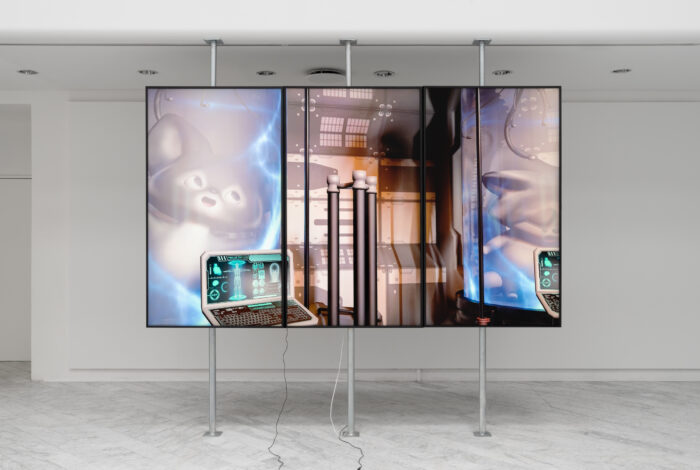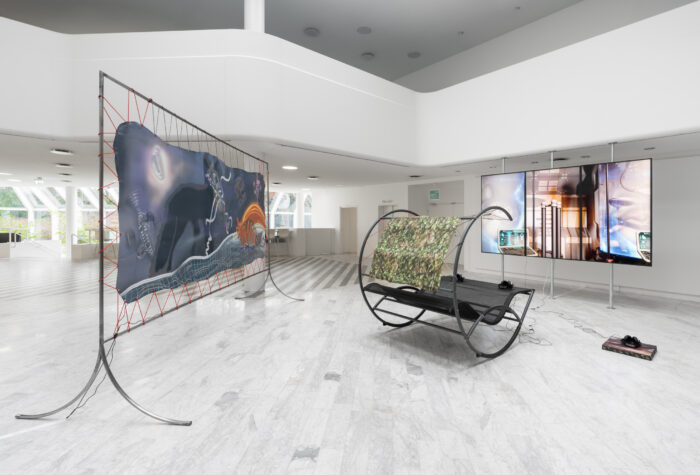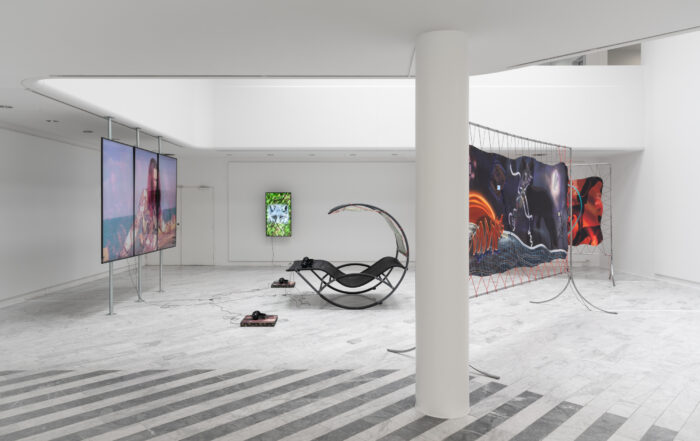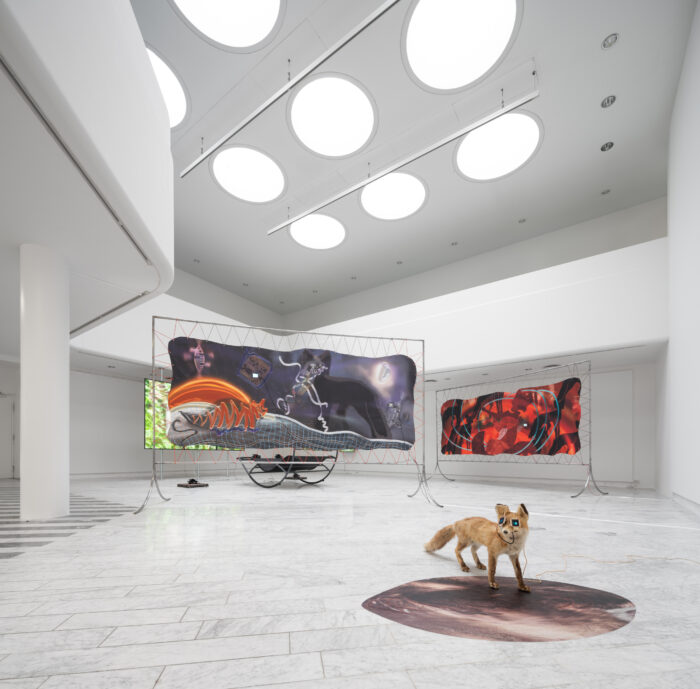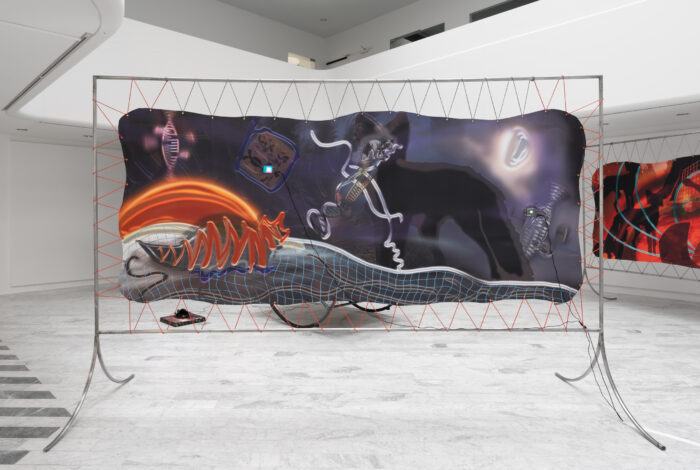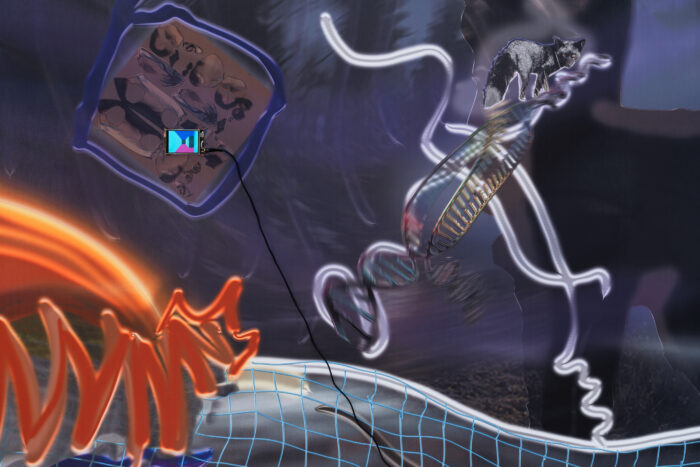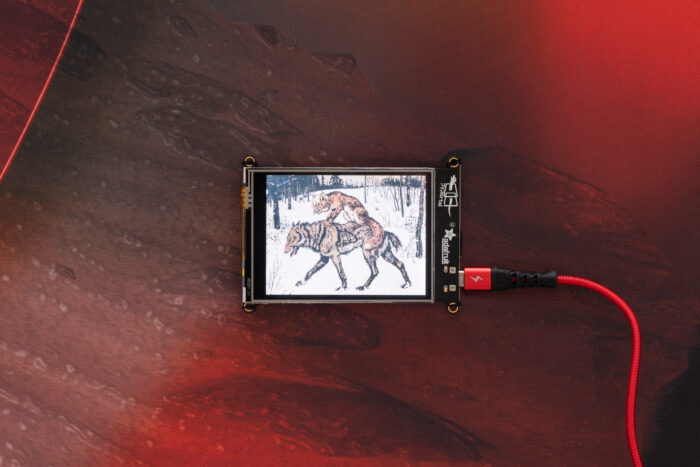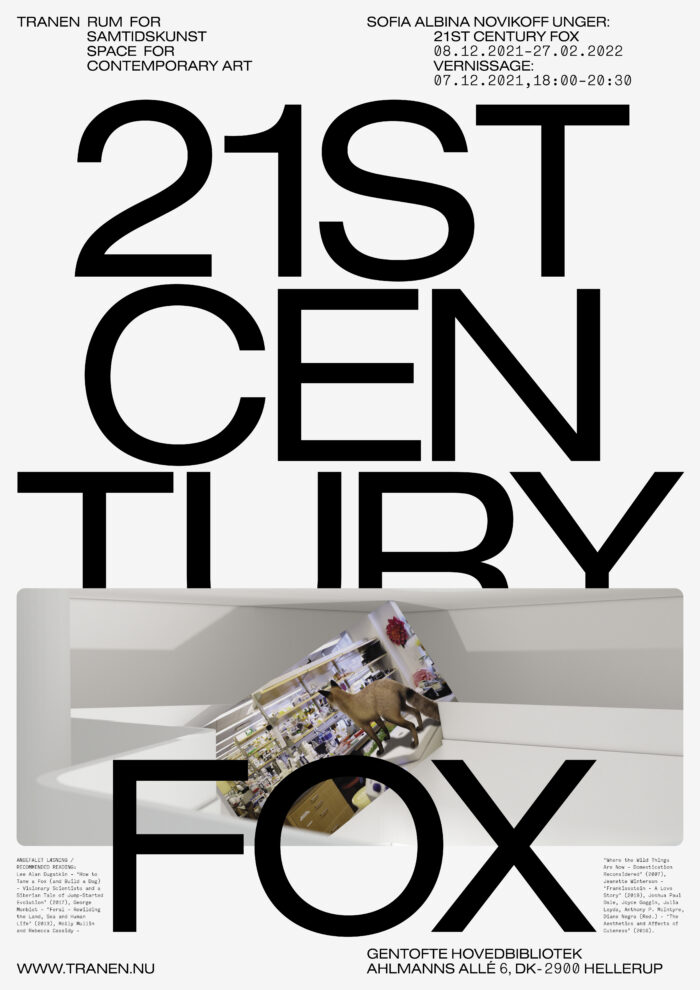Sofia Albina Novikoff Unger
21st Century Fox
08.12.2021–13.03.2022
Vernissage:
07.12.2021,18:00–20:30
I vor hastigt foranderlige verden uddør stadig flere arter. Men enkelte stortrives. En af dem er ræven, som vi møder på Sofia Albina Novikoff Ungers udstilling 21st Century Fox. Fra fabler og eventyr kender vi dette rovdyr som særligt snu. Fra biologer kender vi det som et yderst tilpasningsdygtigt dyr. I kunstnerens version fremstilles ræven som lige så foranderlig som verden selv. Der er ikke en ræv, men en mangfoldighed af ræve. Der er den vilde ræv i naturen, den urbane ræv, den tæmmede ræv, den avlede ræv og den genmodificerede ræv. Der er ræven, som jages af ryttere til hest med hunde i England, og ræven som tilbedes som guddom i Kina og Japan. Der er ræven, som vi mennesker forestiller os og fremstiller den, og ræven, som den forestiller og fremstiller sig selv. Det er i hvert fald Novikoff Ungers historie om ræven, der ikke bare vil være hovedperson men også forfatter til sin egen historie.
Ræve bor typisk med deres unger i rævegrave. Under jorden graver de netværk af gange, der munder ud i ofte flere rævehuller. Ekstra udgange gør det lettere for rævene at undslippe, hvis større rovdyr trænger sig på. Det kan være svært at bestemme, hvor ræve dukker op – og i næste nu forsvinder hen. Ligesom mennesket – og sammen med mennesket – har de spredt sig på tværs af kloden fra Australien til den nordlige polarcirkel. Deres naturlige habitat er skove, sletter og marker men tilpasser sig næsten alle miljøer. Skovrydning og menneskets konstante udvidelse af bygrænserne har ledt nogle ræve til også at udvide deres territorium ind i byerne – og andre til blot at blive boende, hvor mennesket siden har valgt at bosætte sig. I det 19. og især 20. århundredes Europa færdes de stadig mere hjemvant på gader og stræder. I England er ræven nu det største rovdyr i fødekæden; der er ingen over den, ingen der truer den, mennesket undtaget.
På udstillingen 21st Century Fox præsenteres ræve i et utal af overlappende materialer, medier og fortællinger. Det er såvel et sindbillede på ræven som produkt af fortløbende evolution og som ’shapeshifter’ i sydøstasiatisk mytologi. Den første ræv, som man møder på Novikoff Ungers udstilling, er den røde ræv, vulpes vulpes, ved indgangen til Tranen. Den er netop trådt op af et af rævehullerne i marmorgulvet. Den er død og udstoppet, men et par skærme foran dens øjne animerer på ny dens øjne, dens pupillers lodrette sprækker, der begaver denne specialiserede jæger med et andet syn på verden. Rævehullet genkalder en orkans øje, et ormehul eller Lewis Carrolls kaninhul. Det er som en portal til en anden verden, en anden logik, hvor vores velkendte naturlove og sund fornuft forvrænges. Bagved udstrækker sig to store digitale stoftryk. De gengiver tidsrummet fra solen går ned til den på ny står op; tidsrummet, hvor ræve overvejende jager, imens menneskene sover. På stofferne ser vi ræve vandre på DNA-strenges trappetrin, dissekeret og analyseret med kortlægningssoftwaren UV Mapping, bevæge sig ind og ud af forskellige strukturer, multiplicere sig og falde gennem tid og rum.
Igennem de fine stoffer bagved en gyngesofa lyser en stor videovæg op. Her præsenterer Novikoff Unger udstillingens hovedværk. Filmen blander dokumentar og animation, reportage og spekulation, fakta og fiktion. Fortællingen starter i 1959 i Sibirien, hvor genetikeren Dmitry Belyayev eksperimenterer med at avle tamme ræve. Imens det tog tusindvis af år at domesticere hunde, lykkes det for Belyayev og hans hold at domesticere ræven på få årtier. Dens sky og aggressive adfærd er nu imødekommende og menneskevenlig. Dens træk er blødere, rundere, sødere. I et laboratorium i USA øges hastigheden yderligere. Novikoff Unger interviewer genforskere, der nu ved hjælp af CRISPR eksperimenterer med at klippe og klistre i organismers arvemasse. Her arbejdes på at ”genskrive livets molekuler præcis som vi ønsker det.” Vi følger optagelser af ræven, der lever i stadig større kontakt, harmoni og empati med mennesket. Som historien skrider frem, bliver det stadig mere tydeligt, at voice-overen snarere er en rævs stemme end et menneskes. Ræven ligner og opfører sig mere og mere som sin herre. Videnskabsmændene udvikler ræven til et punkt, hvor den kan styre sin egen udvikling. Til sidst låser den sig inde på laboratoriet og genforskerne ude. Novikoff Ungers dokumentar om ræven er også endnu en fabel om ræven og et andet dyr, i dette tilfælde mennesket.
På en mindre skærm på 21st Century Fox præsenteres et kort efterspil. Her tager en ny ræv tager form ved hjælp af billedgenereringteknologien StyleGAN, hvor man kan bestemme input men ikke output.
Sofia Albina Novikoff Unger (f. 1990) er en dansk-russisk kunstner, der arbejder og bor mellem England og Danmark. Hun er uddannet på Otis College of Art and Design, Los Angeles (US), Det Fynske Kunstakademi, Odense (DK), Universität der Künste, Berlin (DE) og Goldsmiths University, London (UK).
21st Century Fox er er en del af Tranens program med ekstemporær kunst. Fokus er på den del af samtidskunsten, som ikke er fokuseret på samtiden. Når alt fra økosystemer til teknologi udvikler sig med stadig højere hastighed, bliver samtiden flygtig og uhåndgribelig. Den skrumper. Til gengæld vokser vor viden om fortiden konstant. Spekulationer om fremtiden tager til. Spørgsmålet om, hvor vi befinder os idag, bliver til et spørgsmål om, hvor vi kommer fra, og hvor vi er på vej hen. Som del af denne bevægelse er megen samtidskunst ikke længere kontemporær, hvilket bogstaveligt talt vil sige ’med tiden.’ I stedet er den ’ekstemporær’, altså ’ude af tiden’ eller samtiden.
Udstillingen er generøst støttet af Statens Kunstfond, Beckett-Fonden, Grosserer L. F. Foghts Fond, Knud Højgaards Fond og Den Hielmstierne-Rosencroneske Stiftelse.
In our rapidly changing world, more and more species are becoming extinct. A few of them are thriving, however. One of them is the fox, which we meet in Sofia Albina Novikoff Unger’s exhibition 21st Century Fox. We recognise this predator from fables and fairy tales as being particularly cunning. From biologists, we know it to be a highly adaptable animal. In the artist’s version, the fox is depicted as being just as changeable as the world itself. We are not talking about one fox, but about a diversity of foxes. There is the wild fox in its natural habitats, the urban fox, the tame fox, the domesticated fox raised for breeding and the genetically-modified fox. There is the fox that is hunted by riders on horseback with hounds in the UK, and the fox that is worshipped as a deity in China and Japan. There is the fox as we humans imagine and depict it, and the fox as it imagines and presents itself. Or at least there is in Novikoff Unger’s depiction of the fox, which is not content to be the protagonist, but also wants to be the author of its own narrative.
Foxes typically live with their young in burrows. They dig a network of underground tunnels, which lead to several foxholes. Additional exits make it easier for the foxes to escape in case of an intruder. It can be hard to determine where foxes will show up one moment – only to disappear the next. Just like humans – and together with them – they have spread across the globe, from Australia to the Arctic Circle. Their natural habitats are woodland, plains and fields, but they can adapt to almost any environment. Deforestation and humanity’s constant expansion of urban boundaries has led some foxes to expand their territory into cities – and others simply to remain where people have opted to settle. In 19th- and 20th-century Europe in particular, they have become ever more accustomed to life on the streets. In the UK, the fox is now the apex predator at the top of the food chain, threatened only by humans.
In the exhibition 21st Century Fox, this species is presented in a myriad of overlapping materials, media and narratives. It presents a view of the fox as a product of continuous evolution and as a ‘shapeshifter’ in Southeast Asian mythology. The first fox we encounter in Novikoff Unger’s exhibition is the red fox, Vulpes vulpes, at the entrance to Tranen. It has just stepped out of one of the foxholes in the marble floor. It is dead and stuffed, but a couple of screens in front of its eyes reanimate them. Its vertically split pupils endow this specialised hunter with another view of the world. The foxhole recalls the eye of a hurricane, a wormhole or Lewis Carroll’s rabbit hole. It is like a portal to another world – a different logic, in which our familiar laws of nature and common sense are distorted. Behind this are two large, outstretched digital textile prints. They recreate the time period from when the sun goes down to when it rises again: a time the fox predominantly spends hunting as people sleep. On the textiles, we see foxes dissected and analysed using the mapping software UV Mapping, climb up the steps of DNA strands, move in and out of various structures, multiply and fall through space and time.
Through the fine fabrics of a porch swing, a large video wall lights up. Here, Novikoff Unger presents the main work in the exhibition. The film blends documentary and animation, reportage and speculation, facts and fiction. The narrative begins in 1959 in Siberia, where the geneticist Dmitry Belyayev experiments with breeding tame foxes. While it took thousands of years to domesticate dogs, Belyayev and his team were able to domesticate the fox in just a few decades. No longer shy and aggressive, it has become accommodating and friendly towards people. Its features are softer, rounder and more pleasant. In a laboratory in the United States, this rate is further increasing. Novikoff Unger interviews geneticists, who are now using CRISPR gene editing to cut and paste into the DNA of organisms. Here, work is done on rewriting “the molecules of life any way we wish”. We follow recordings of the fox, which lives in ever greater contact, harmony and empathy with humans. As the story progresses, it becomes increasingly clear that the voiceover is a fox’s voice and not a human’s. More and more, the fox starts to resemble and behave like its master. Scientists are developing the fox to a point where it can control its own development. Finally, it locks itself inside the laboratory and locks the geneticists out. Novikoff Unger’s documentary about the fox is also yet another fable about the fox and another animal – in this case a human.
A smaller screen in 21st Century Fox presents a short epilogue. Here, a new fox takes shape using the image generating technology StyleGAN, where you can choose the input, but not the output.
Sofia Albina Novikoff Unger (born 1990) is a Danish-Russian artist who lives and works between the UK and Denmark. She studied at Otis College of Art and Design, Los Angeles (US), Funen Art Academy, Odense (DK), Universität der Künste, Berlin (DE) and Goldsmiths University, London (UK).
21st Century Fox is a part of Tranen’s programme of extemporary art. The focus is on contemporary art that is not primarily focused on our contemporary condition. When everything from climate to technology evolves at ever greater pace, the present becomes ephemeral and intangible. The present starts to shrink. Meanwhile, our knowledge of the past increases. Speculations about the future abound. As part of this development, a lot of art is no longer contemporary — which literally means ‘with time.’ Instead, art is rather ‘extemporary, i.e. ‘out of time’.
The exhibition is generously supported by the Danish Arts Foundation, Beckett-Fonden, Grosserer L. F. Foghts Fond, Knud Højgaards Fond and Den Hielmstierne-Rosencroneske Stiftelse.
Anbefalet læsning / Recommended reading:
Forfatter / Author
Titel / Title
Udgivelsesår / Publication date
Lee Alan Dugatkin, Lyudmila Trut
How to Tame a Fox (and Build a Dog) - Visionary Scientists and a Siberian Tale of Jump-Started Evolution
2017
George Monbiot
Feral - Rewilding the Land, Sea and Human Life
2013
Molly Mullin, Rebecca Cassidy
Where the Wild Things Are Now - Domestication Reconsidered
2007
Jeanette Winterson
Frankissstein - A Love Story
2019
Joshua Paul Dale, Joyce Goggin, Julia Leyda, Anthony P. McIntyre, Diane Negra (Red.)
The Aesthetics and Affects of Cuteness
2016
Æsop
Æsops Fabler. Genfortalt af Gabriela og Vagn Lundbye
2003
